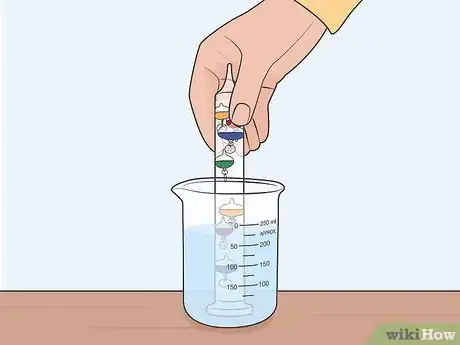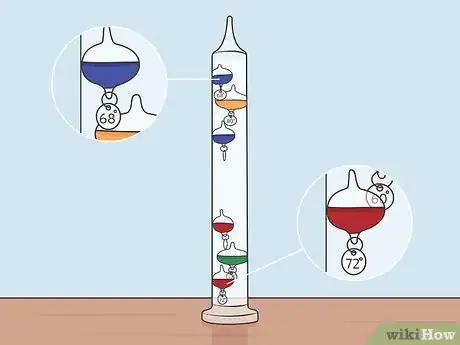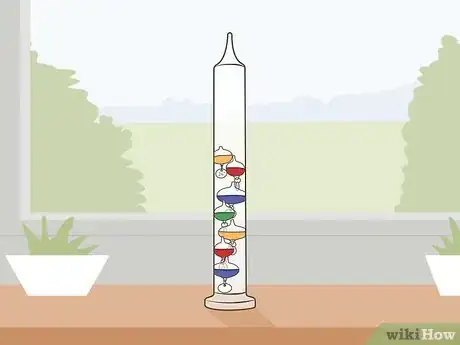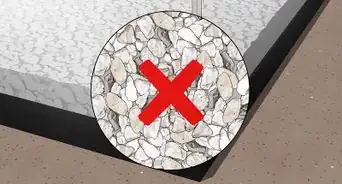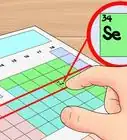This article was co-authored by wikiHow Staff. Our trained team of editors and researchers validate articles for accuracy and comprehensiveness. wikiHow's Content Management Team carefully monitors the work from our editorial staff to ensure that each article is backed by trusted research and meets our high quality standards.
This article has been viewed 73,400 times.
Learn more...
Galileo thermometers are glass tubes filled with floating colorful spheres. They’re based on Galileo Galilei’s invention, the thermoscope. Changing temperatures cause the colorful orbs to either sink or float inside the glass tube. You can tell the temperature by reading the medallion on the middle floating sphere, if there are clusters of spheres at the top and the bottom of the tube, or with a few other tricks, depending on the configuration of the spheres.
Steps
Positioning the Thermometer
-
1Identify the temperature stamped onto each medallion. The thermometer consists of a glass tube filled with a clear liquid, in which colored glass spheres float. Each sphere has a metal medallion hanging from it. The medallions are different weights, which makes the spheres float or sink different amounts.[1]
- Look closely at each metal medallion. You will see a temperature engraved onto it.
- Different Galileo thermometers have different ranges of temperatures that they can report. For example, many have a range of 60 °F (16 °C) to 100 °F (38 °C) and won't tell you the temperature if it's higher or lower than those values.
-
2Note that the spheres sink when it's hot out and float when it’s cool. The Galileo thermometer works because of the principle of buoyancy, which states that objects that are denser than their surroundings sink, and objects that are less dense than their surroundings float. The temperature surrounding the thermometer will make the liquid in the thermometer more dense as it cools, or less dense as it heats up. The spheres will sink when the temperature is hot, and float when the temperature is cool.[2]
- The spheres also contain liquid, but it changes density much less rapidly than the clear liquid in the thermometer, so it isn’t affected by the temperature change.
- The spheres are different colors just to look beautiful.
Advertisement -
3Hang the thermometer from a hook to find out the air temperature. You can hang the thermometer inside or outside. The key is to not hold the thermometer in your hands because your hands will warm it up and give a skewed reading. The spheres in the thermometer take a few minutes to float to the correct places.[3]
- Keep in mind that Galileo thermometers are not super precise. They’ll be able to tell you roughly the temperature of the room, within 4 °F (−16 °C). Their main benefit is that they're beautiful, with all those floating glass spheres.
-
4Place the thermometer in a beaker of water to test the water temperature. This is a good way to demonstrate using the thermometer, especially if you’re doing it in a classroom. Full a big beaker with water that’s either colder or warmer than the ambient temperature of the room. Then put in the Galileo thermometer.[4]
- Using a beaker of water is great for a classroom demonstration because the temperature change between the air and the water makes for a dramatic show.
Reading the Temperature Properly
-
1Read the temperature of the sphere floating in the middle of the tube if there is one. Sometimes a cluster of spheres floats by the top of the tube, and a cluster sinks to the bottom, while one sphere hangs in the middle. If that’s the case, read the temperature tag on the middle sphere.[5]
- This is the most common scenario.
-
2Average the lowest and highest spheres if there isn't one in the middle. In some cases, there will be 2 groups of spheres hanging out, 1 in the top of the tube and 1 in the bottom. If that’s the case, read the temperature of the lowest sphere in the top group and the highest sphere in the bottom group. Take the average by adding them together and dividing by 2. That’s your temperature.[6]
- For example, if one sphere says 72 and one says 68, your average temperature would be 70.
-
3Mark the temperature as colder than the highest sphere if they all float. When the outside temperature is quite cold, all of the spheres will float toward the top of the tube. Read the temperature on the highest of the floating spheres. The ambient temperature is colder than that reading.[7]
- The spheres float because the liquid inside the tube becomes denser than the spheres.
-
4Note that the temperature is hotter than the lowest sphere if they all sink. The Galileo thermometer doesn’t measure accurately at really high temperatures. All the spheres will sink toward the bottom of the tube, and all you’ll know is that the temperature is hotter than the one on the medallion of the lowest sphere.[8]
- The spheres sink in high temperatures because as the liquid in the tube heats up, it becomes less dense than the spheres.
References
- ↑ https://youtu.be/nrgD74Sc5VM?t=44
- ↑ https://sciencing.com/read-galileo-thermometer-4885223.html
- ↑ https://sciencing.com/instructions-galileo-thermometer-7572595.html
- ↑ https://youtu.be/nrgD74Sc5VM?t=122
- ↑ http://www.4physics.com/phy_demo/Galileo_thermometer/galileo-thermometer-b.html
- ↑ https://sciencing.com/instructions-galileo-thermometer-7572595.html
- ↑ https://sciencing.com/instructions-galileo-thermometer-7572595.html
- ↑ https://sciencing.com/instructions-galileo-thermometer-7572595.html



